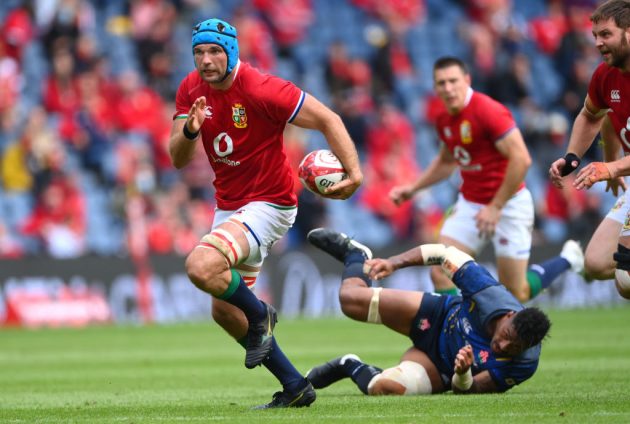From roaring Lions to domestic finals, Paul Williams reflects on the rugby happenings of the past few weeks
Lions tour starts with a bang, a few bangs
Warren Gatland will be pleased with the British & Irish Lions 2021 opener against Japan. Comfortable wins early on in Lions tours are rare, especially against solid Test-level opposition.
The early combinations worked well, with Dan Biggar, Bundee Aki and Robbie Henshaw presenting a solid blueprint for what we can expect in the Test matches against South Africa. Biggar, in particular, was beautifully efficient and continued his immaculate Premiership form – he is playing the best rugby of his career.
Jack Conan carried well through contact and Tadhg Beirne once again started the game like a forward and finished it like a back.
Perhaps the most pleasing performance was from Duhan van de Merwe, who delivered a level of hunger not seen since Oliver Twist played on the flank for the East London XV back in the mid-1800s.
But whilst it was a victory, there were losses. To lose your captain for the tour is a massive blow for any number of playing and commercial reasons. The commercial reasons are often overlooked because the playing implications are so prominent, but spare a thought for all the sponsors who have Alun Wyn Jones emblazoned all over their promos.
Justin Tipuric’s injury is also a massive blow, as players with his unique skill-set are rare. However, cope the Lions will – as they always do. Josh Navidi and Adam Beard are fantastic replacements, and both will be genuine options for the Test team; Beard will surprise many with his contribution.
Beauty of Japanese handling
Many aspects of Japanese culture are often revered for their beauty and intricacy. Their handling in midfield needs to be added to that list.
To see the Japanese back-line pass around the blitz defence is something to behold. Against the Lions, Japan completed 269 passes to the Lions’ 151 – that’s a big difference.
Japan score their first points of the day ?
Off the back of a line-out, the Japanese forwards get a roll going before Kazuki Himeno goes down for their first score.#LionsRugby | #1888Cup | @VodafoneUK pic.twitter.com/Da19PjtjUQ
— Channel 4 Sport (@C4Sport) June 26, 2021
The handling of the entire squad is both a thing of beauty and necessity. Without a stack of big ball-carriers, rapid width and changing of contact points is vital.
And whilst the handling of the entire squad is precise, the contribution of Timothy Lafaele at 13 is the highlight. His ability to take and give a pass is so fast that even an atomic clock would struggle to log it.
Japan may have lost, but they remain a pleasure to watch.
Harlequins and Benetton spin rugby on its head
In June, Harlequins and Benetton altered the season to a degree that even climate change experts struggled to comprehend.
Harlequins pre-Christmas, and Benetton pre-April, were experiencing a dry spell not witnessed since the desertification of North Africa 5,000 years ago. But then it all changed. Harlequins won the Gallagher Premiership with two stunning performances against Bristol and Exeter, and Benetton thumped the Bulls in the Rainbow Cup final.
The turnaround in each club’s fortunes were very different. At Harlequins, the playing staff remained the same and a coaching change was the instigator. At Benetton, the coaching staff remained the same and a stack of players returned from injury and Test duty.
Either way both teams delivered arguably the greatest mid-season turnaround in either league. And both teams brought a level of romance and randomness to elite club rugby that has been lacking in previous seasons.
? Most tries in a Premiership final
? Most points in a Premiership final? The ???? #GallagherPremFinal ????!
? Highlights as @Harlequins delivered the ultimate team performance! ? pic.twitter.com/Y0cxUkt7M3
— Rugby on BT Sport (@btsportrugby) June 27, 2021
Homogenized, budget-led, risk-free rugby seemed like it was the only way to win in anything in modern rugby. Until now. Harlequins and Benetton have shown that whatever rugby blueprints you hold dear, can potentially be used as toilet roll should we go into another lockdown.
And Quins are more than heads-up rugby
You could be forgiven for thinking that Harlequins won the league with a series of high-risk, attack-led performances. And you’d be right to a degree. Watching Marcus Smith, Danny Care, Alex Dombrandt and Joe Marchant cutting angles like a Greek stonemason is a joy to watch. But it’s not all heads-up rugby.
It all starts with the lads who keep their heads down. With Joe Marler, Scott Baldwin, Wilco Louw and the coaching of Adam Jones, Quins’ scrum moved Exeter backwards to the point that they were encroaching the Covid distancing required between those on the field and those in the stands.
1269 – @JoeMarler played more minutes (1,269) than any other prop in @premrugby this season; he also averaged the 2nd most carries (9.4) per 80 minutes of any of the 34 props to play 500+ mins in the campaign. Indefatigable. pic.twitter.com/WVh9bl7vPd
— OptaJonny (@OptaJonny) June 28, 2021
There weren’t any overtly tricksy angles or ‘grey’ areas. This was straight-backed weight pushing the middle like a skewer moving through kebab.
Quins have a reputation for doing things with the ball, but they also shone without the ball against Exeter. They managed a Test-level 91% defensive completion, which against many teams would have been enough to reduce the opposition to one or two tries. But such is Exeter’s proficiency with the tight stuff, from five metres out, they still managed to score five tries – there is only so much defending you can do on your own try-line.
With the maulers having done their job, the ballers could do theirs and boy did they. With parity of possession, a rarity for anyone who plays against Exeter, Dombrandt found more space than a sevens player, Smith looked like he was living in a computer game and Marchant played like the next England 13 in waiting.
Exeter will have their day again. But for now, Harlequins are playing the best rugby in England and it’s beautiful.
MORE ON HARLEQUINS
Harlequins are English champions after epic final win over Exeter
The script writers excel themselves – this was…
The rocky rise of Joe Marler
Perseverance and a new outlook have helped the…
Meet Harlequins half-backs Danny Care and Marcus Smith
Their form has propelled Quins into the Premiership…
Toulouse, kick it
Rain heavily affected the quality of rugby on show in the Top 14 final. But it didn’t affect the quality of Toulouse’s decision-making.
Of the two sides, we would have expected La Rochelle, with their Lord of the Rings pack, to make the hard yards easier. But that wasn’t how it turned out. Toulouse, from the outset, played knockout rugby. Taking every single chance to secure points when they entered the 22.
And not just for penalty kicks. Toulouse went full knockout rugby with a selection of early drop-goals and Cheslin Kolbe added to his already mythical skill-set with a 50m strike that was cleaner than Matt Hancock’s desk.
#FinaleTOP14 @Cheslin_Kolbe11 sait vraiment tout faire ?
Quel drop de 50 mètres de l'arrière du @StadeToulousain juste avant la pause ? pic.twitter.com/1kOI7Z0k7u
— TOP 14 Rugby (@top14rugby) June 26, 2021
Toulouse were the deserving winners and showed why they are rugby’s true northern hemisphere dynasty.
Related: The Fallacy of French Flair
North and south poles apart on high shots
The gap between the northern and southern hemisphere playing styles became less pronounced more than a decade ago. The cross-pollination of players and coaches has meant both hemispheres now benefit from the sharing of knowledge.
However, with the new high tackle interpretations a gap appears to have opened between the north and south with regards to refereeing. This is not a criticism of individual referees, but a wider interpretation of how the laws seem to be applied across competitions.
The Super Rugby Trans-Tasman final was a classic example. Highlanders hooker Ash Dixon caught Blues’ Otere Black square on the head, with the shoulder, with no change in height from the ball-carrier, yet it was deemed a yellow card.
Ash Dixon yellow carded for this tackle on Otere Black, should it have been more? ?#SuperRugbyTT #BLUvHIG
— Ultimate Rugby (@ultimaterugby) June 19, 2021
The two hemispheres need to come together for the safety of players and the consistency of Test matches.
Can’t get to the shops? You can download the digital edition of Rugby World straight to your tablet or subscribe to the print edition to get the magazine delivered to your door.
Follow Rugby World on Facebook, Instagram and Twitter.









